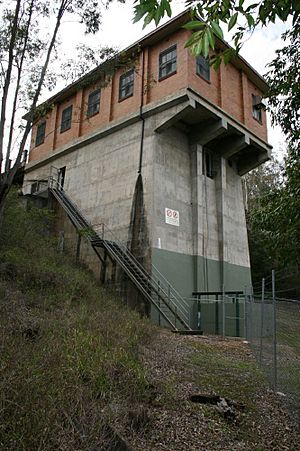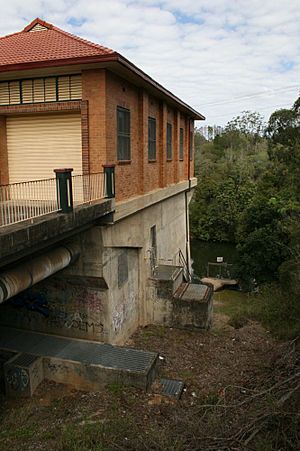North Pine Pumping Station facts for kids
Quick facts for kids North Pine Pumping Station |
|
|---|---|

North Pine Pumping Station, 2007
|
|
| Location | Lake Kurwongbah-Dayboro Road, Kurwongbah, Moreton Bay Region, Queensland, Australia |
| Design period | 1940s - 1960s (post-World War II) |
| Built | 1956-1961 |
| Official name: North Pine Pumping Station, Dayboro Road Pumping Station | |
| Type | state heritage (built) |
| Designated | 28 January 2009 |
| Reference no. | 602691 |
| Significant period | 1950s-1960s |
| Significant components | watercourse - river, crane / gantry, dam/reservoir, machinery/plant/equipment - utilities - water supply, pump |
| Builders | K D Morris & Sons Pty Ltd |
| Lua error in Module:Location_map at line 420: attempt to index field 'wikibase' (a nil value). | |
The North Pine Pumping Station is a special old building in Kurwongbah, Queensland. It's called "heritage-listed" because it's an important part of history. This station helps move water. It was built between 1956 and 1961 by a company called K D Morris & Sons Pty Ltd. You might also hear it called the Dayboro Road Pumping Station. It was added to the Queensland Heritage Register on January 28, 2009.
Contents
Why the Pumping Station Was Built
The North Pine Pumping Station is on Dayboro Road, near Lake Kurwongbah. It's a key part of the North Pine Water Supply scheme. This plan was made in the late 1950s. Its main job was to provide water to the areas of Pine Rivers and Redcliffe. It also supplied water to a large paper mill in Petrie.
Planning for Water Supply
In 1946, people first talked about getting water to towns like Strathpine and Kallangur. But before they could start, a big paper company, Australian Paper Manufacturers (APM), needed a lot of water. APM, now called Amcor, was planning to build a large carton board mill in Petrie. Making cardboard needs huge amounts of water. So, a good water supply was very important for the new mill.
APM suggested a plan to get water from the North Pine River. In 1949, the Pine Shire Council agreed to build this system. They also changed the plan so they could get water from a dam on Sideling Creek if needed. The Queensland Government approved the whole idea in 1953. By 1954, the plan grew even bigger. It would also supply water to the town of Redcliffe.
A Big Project for Queensland
The APM mill in Petrie was a very large industrial project after World War II. It was one of the biggest private factories built in Queensland at that time. It helped Queensland grow its industries after the war. The government even helped APM build the mill. They also helped pay for the water supply system. They gave half the money and helped get loans. The Petrie Mill became very important. By 2004, it was the only factory in Australia making a special type of carton board.
The Agreement and Construction
An important agreement was signed in 1955. It was between the Pine Shire Council, Redcliffe Town Council, and APM. The Premier of Queensland was even there! This agreement said that the Pine Shire Council would supply water to APM and Redcliffe for 60 years.
The council was in charge of building the water system. This included three main parts:
- The pumping station
- A dam on Sideling Creek
- A water filtration plant
Engineers helped design and manage the project. The pumping station was the first big part to be built. Work started on February 18, 1956. The Queensland Treasurer said the pump house was the "heart" of the whole plan.
Building the Pumping Station
The company KD Morris & Sons Pty Ltd finished building the pump house in mid-1957. Other companies installed the pumps. When it was new, the station had four large pumps. These pumps could move water from the North Pine River or from the dam on Sideling Creek. This dam later became known as Lake Kurwongbah. Water from the dam came through a tunnel under the road. The station could also pump water from the river into the dam to fill it up. The pumping station cost about £86,000 back then.
The building was designed like other pump stations of its time. The pumps are placed below the river level. This means that even though the building looks like one storey from the road, the main pump floor is more than 20 meters (about 65 feet) below the entrance. The control room and offices are higher up, safe from floods.
The whole water supply system officially opened in April 1961. It had already started supplying water to the APM mill in 1957. When it opened, it was Queensland's third largest water supply system outside of Brisbane. The total cost was about £1,000,000.
Changes Over Time
Since it was built, the pumping station has changed a bit. The roof tiles have been replaced. Inside, the pumps have been updated to be more modern. Also, the station used to be controlled by people, but now computers run it.
The new mill and water supply helped the Pine Shire grow a lot. By 1961, new houses were being built very quickly. The small farming towns in the area started to become busy suburbs of Brisbane.
What the Pumping Station Looks Like
The North Pine Pumping Station is located near a bend in Dayboro Road. It sits with its back to the North Pine River. From the road, it looks like a simple, single-storey building made of orange bricks. It has a tiled hip roof. This part of the building holds the control room.
The main parts of the pumping station are:
- The river inlet (where water comes in)
- The basement and chamber (where the pumps are)
- The control room
Today, computers control everything, so the station can run by itself.
Building Design
The building has two main levels. It's designed to efficiently take water from the river and pump it to the water treatment plant or to Lake Kurwongbah. The building rises about 20 meters (65 feet) from the riverbank. It's like a concrete tower that supports the control room floor.
You reach the building by a concrete driveway from Dayboro Road. It has two entrances. The main entrance has a wooden door with a fancy metal screen. The other is a roller door. Above the main entrance, it says "Pine Shire Council Pumping Station." There's also a plaque near the entrance that remembers when construction started.
The long sides of the building have five sections. Each section has a narrow window with frosted glass. The side facing the river has three sections with similar windows.
Inside the Station
The entrance level has a small lobby, an office, and the control room. The office has a desk and a window looking into the control room. The control room floor has six metal grates that can be removed. These grates allow access to the pumps and machinery below. When a grate is open, a safety barrier is put around the hole. The control room has metal cabinets that hold the computers that run the pumps. A large crane on rails can move along the length of the room. This crane helps lift heavy equipment. The inside walls are plastered and painted. Concrete steps lead down from the control room to the basement.
Some old parts from when the station was controlled by hand are still there. The old wheel handles for the valves are gone, but you can see where they used to be. There's also an old hydraulic control machine near the roller door. It used to open and close the valves. This old system doesn't work anymore.
Below the control room is a large, open space called the chamber. It drops down three to four storeys to the basement level. This is where the pumps, pipes, valves, and motors are. There are six modern pumps that can change their speed. Metal walkways and stairs go around the inside of this chamber. There are also windows in the chamber walls.
Water Intake and Other Features
From the control room, a door leads to metal stairs outside. These stairs go down to the river intake area. This is where water is drawn from the river. Metal screens stop large debris from entering. A special hook and pulley system helps pull these screens up for cleaning. Water enters the station through these screens. Then, electric motors in the basement power the pumps. The water is then sent through large pipes to the water treatment plant or into Lake Kurwongbah dam. Water can also be pumped from the dam to the treatment plant.
There are also more pipes and valves hidden under the outside stairs and the driveway. A small brick toilet building is located near the station. You can also see piles of old roof tiles behind the toilet. The pumping station is surrounded by grassy fields and trees. A barbed wire fence goes around the property.
Why It's a Heritage Site
The North Pine Pumping Station was added to the Queensland Heritage Register on January 28, 2009. This means it's considered an important historical place.
Showing Queensland's History
The pumping station is important because it shows how Queensland's history has changed. It was a key part of the APM Cartonboard Mill in Petrie, which was a very big industrial project after World War II. Before the war, Queensland didn't have many factories. The pumping station shows how the state grew its industries in the 1950s.
It was also part of the first water system for the Pine Shire. This system helped the area grow a lot in the 1950s and 1960s. It shows how small country towns near Brisbane started to become bigger suburbs.
A Special Type of Building
The North Pine Pumping Station is a well-designed utility building. It's a small industrial building made to pump water. Even though it's now run by computers, it still has many of its original parts. It shows what a pumping station of its type should look like. It appears as a single-storey building from the road, but most of its structure is hidden below. The pumps are below river level. They draw water into pipes and send it to the water treatment plant. The basement holds the main pumping equipment. The control room is safely above flood level. It holds the equipment that runs and watches over the pumps.
Its Beauty and Importance
The pumping station is in a pretty setting, looking over the North Pine River and Lake Kurwongbah. It's a strong, practical building with a classic look. It's a surprisingly beautiful utility structure. From the river, the building looks very dramatic as it rises up like a tall concrete shaft.
Connected to Important Work
The pumping station was a vital part of the Australian Paper Manufacturers' Mill. This mill was the largest project in Southern Queensland after the war. So, the station is closely linked to a very important company in Australia's history.


